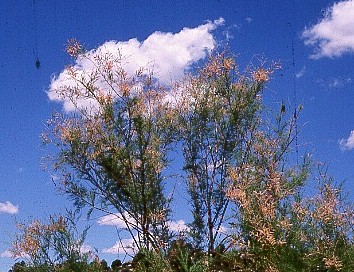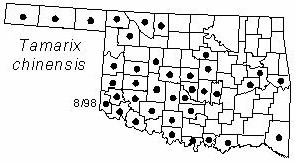
Small tree or shrub to 6 m (20 ft) tall. Twigs long, thin, glabrous, reddish or purplish, shedding with the leaves in Fall. Bark brown to gray, smooth on young branches, becoming rough and furrowed on older branches and trunks. Buds very small. Leaves numerous, alternate, scale-like (resembling those of Juniperus), about 1.5 mm (1/16 in) long, sharp-pointed, blue-green. Flowers numerous, very small, crowded in racemes 2-5 cm (0.8-2 in) long, pink to whitish, blooming in Spring and Summer. Fruits numerous pointed reddish-brown capsules about 3 mm (1/8 in) long, maturing in late Summer or Fall.
Distribution: Native to Asia and eastern Europe, but naturalized in much of the Western U. S. and northern Mexico.
Habitat: Streambanks and sandy floodplains.
NWI status: FACW
Comment: Salt cedar is considered a nuisance in the southwest because of its habit of growing in dense thickets along streams and irrigation canals, where it consumes large amounts of water. Tamarix is the old Latin name; chinensis refers to China.
Distribution in Oklahoma: 
BACK
NEXT
RETURN TO INDEX
Last update: 9/20/99
 Go to Oklahoma Biological Survey Home Page
Go to Oklahoma Biological Survey Home Page
 Disclaimer
Disclaimer